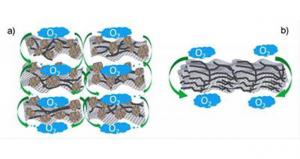Researchers at the Case Western Reserve University have made a step towards making low-cost catalysts commercially available, which could, in turn, reduce the cost to generate clean energy from PEM fuel cells--the most common cell being tested and used in cars and stationary power plants.

The researchers examined a non-metal catalyst to perform in acid because the standard bearer among fuel cells, the PEM (proton exchange membrane/polymer electrolyte membrane) cell uses an acidic electrolyte. The catalyst is based on a porous structure, with sheets of nitrogen-doped graphene mixed with carbon nanotubes and carbon black particles in a solution, freeze-dried into composite sheets and hardened.
Testing showed the porous catalyst performs better and is more durable than an iron-based catalyst. The researchers continue to study the materials and structure as well as investigate the use of non-metal catalysts in more areas of clean energy.